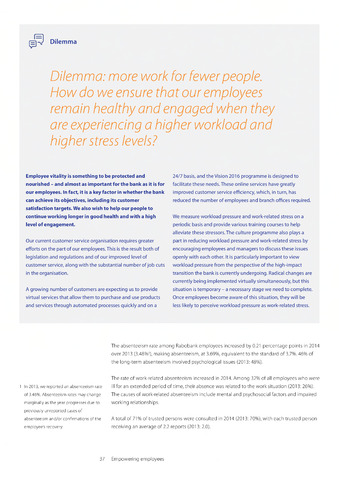Dilemma: more work for fewer people.
How do we ensure that our employees
remain healthy and engaged when they
are experiencing a higher workload and
higher stress levels?
Dilemma
Employee vitality is something to be protected and
nourished - and almost as important for the bank as it is for
our employees. In fact, it is a key factor in whether the bank
can achieve its objectives, including its customer
satisfaction targets. We also wish to help our people to
continue working longer in good health and with a high
level of engagement.
Our current customer service organisation requires greater
efforts on the part of our employees. This is the result both of
legislation and regulations and of our improved level of
customer service, along with the substantial number of job cuts
in the organisation.
A growing number of customers are expecting us to provide
virtual services that allow them to purchase and use products
and services through automated processes quickly and on a
24/7 basis, and the Vision 2016 programme is designed to
facilitate these needs. These online services have greatly
improved customer service efficiency, which, in turn, has
reduced the number of employees and branch offices required.
We measure workload pressure and work-related stress on a
periodic basis and provide various training courses to help
alleviate these stressors.The culture programme also plays a
part in reducing workload pressure and work-related stress by
encouraging employees and managers to discuss these issues
openly with each other. It is particularly important to view
workload pressure from the perspective of the high-impact
transition the bank is currently undergoing. Radical changes are
currently being implemented virtually simultaneously, but this
situation is temporary - a necessary stage we need to complete.
Once employees become aware of this situation, they will be
less likely to perceive workload pressure as work-related stress.
The absenteeism rate among Rabobank employees increased by 0.21 percentage points in 2014
over 2013 (3.48%'), making absenteeism, at 3.69%, equivalent to the standard of 3.7%. 46% of
the long-term absenteeism involved psychological issues (2013:48%).
1 In 2013, we reported an absenteeism rate
of 3.46%. Absenteeism rates may change
marginally as the year progresses due to
previously unreported cases of
absenteeism and/or confirmations of the
employee's recovery.
The rate of work-related absenteeism increased in 2014. Among 32% of all employees who were
ill for an extended period of time, their absence was related to the work situation (2013: 26%).
The causes of work-related absenteeism include mental and psychosocial factors and impaired
working relationships.
A total of 71% of trusted persons were consulted in 2014 (2013: 70%), with each trusted person
receiving an average of 2.2 reports (2013: 2.0).
37 Empowering employees

